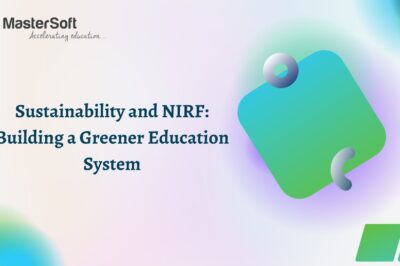Sustainability and NIRF: Building a Greener Education System
In an era where environmental concerns have become paramount, the integration of sustainability into various facets of society is not just a choice but a necessity. The education system, being a cornerstone of societal development, has a crucial role to play in fostering a sustainable future. The National Institutional Ranking Framework (NIRF) in India, which evaluates and ranks educational institutions, can serve as a powerful catalyst for building a greener and more environmentally conscious education system.
Understanding Sustainability in Education:
Sustainability in education goes beyond incorporating green technologies and practices. It encompasses a holistic approach that integrates environmental, social, and economic dimensions into the curriculum, campus operations, and overall ethos of educational institutions. This approach not only instills eco-consciousness in students but also prepares them to address complex global challenges related to climate change, resource depletion, and social inequality.
The NCTE is involved in the planning and coordination of teacher education programs at various levels to ensure uniformity and quality.
The Role of NIRF in Shaping Educational Priorities:
The NIRF, initiated by the Government of India, plays a pivotal role in evaluating and ranking higher education institutions across the country. While the primary focus has traditionally been on academic excellence, NIRF has the potential to influence institutions to adopt sustainable practices. By incorporating sustainability criteria into its evaluation parameters, NIRF can motivate educational institutions to prioritize environmental responsibility.
- Curriculum Development: Sustainability should be woven into the fabric of academic programs. NIRF can encourage institutions to develop courses that explicitly address environmental issues, sustainable development, and responsible citizenship. By awarding higher rankings to institutions with comprehensive sustainability-focused curricula, NIRF can drive a shift towards environmentally conscious education.
- Research Emphasis: Sustainable practices often emerge from innovative research. NIRF can promote sustainability by giving higher weightage to institutions engaged in research projects that address environmental challenges, alternative energy solutions, and sustainable technologies. This emphasis on research can incentivize institutions to contribute meaningfully to the global knowledge pool on sustainability.
- Campus Infrastructure and Operations: Beyond academics, the physical infrastructure and daily operations of educational institutions significantly impact the environment. NIRF can integrate criteria related to green building practices, waste management, energy efficiency, and water conservation into its evaluation framework. This would encourage institutions to adopt eco-friendly practices in their day-to-day operations, contributing to a greener campus.
- Community Engagement: A truly sustainable education system extends its impact beyond the campus boundaries. NIRF can recognize and reward institutions that actively engage with local communities to address environmental challenges. This includes initiatives such as tree planting drives, waste management programs, and community education on sustainability issues.
- Student Involvement: Students are the driving force behind change. NIRF can acknowledge institutions that foster a culture of environmental responsibility among students. This could involve recognizing student-led sustainability initiatives, encouraging eco-clubs, and promoting environmentally focused extracurricular activities.
Challenges and Opportunities:
While integrating sustainability into the NIRF framework presents significant opportunities, it also comes with its set of challenges. Resistance to change, resource constraints, and varying levels of awareness among educational institutions are potential obstacles. However, these challenges can be addressed through targeted capacity-building programs, financial incentives, and awareness campaigns.
Conclusion:
In conclusion, the synergy between sustainability and the National Institutional Ranking Framework has the potential to shape a greener and more responsible education system in India. By aligning academic excellence with environmental consciousness, NIRF can drive a paradigm shift in educational priorities. The future lies in nurturing a generation of students who not only excel in their chosen fields but also understand the importance of preserving and protecting the planet for generations to come. The integration of sustainability into NIRF is not just a ranking criterion; it is a commitment to building a better, greener, and more sustainable future through education.
